6. BioFabricating Materials¶
Before starting to explain what we did today, I would like to state that it has been one of the most inspiring week of Fabricademy. This week was all about finding less polluting, biosourced alternatives to all the disposables we use and overconsume in our daily life.

One of the biggest problems of these times is the overproduction of plastic and cotton and the accumulation of it in nature. Plastic is a substance the earth cannot digest. Plastic is an amazing material used in the wrong way. It has incredible proprieties and can be used in a lot of different ways, resulting in different elasticities, textures and flexibilities. Assembling, bonding, finishings, sewing, cutting, machining, thermoforming, casting, extruding, 3D printing are a non exhaustive list of the different actions that can be done using plastic. The problem: it has a life spawn of hundreds of years but is used for disposable objects used for 30 mins or less. And while it has huge advantages, there are also a lot of issues with plastic: it never goes away, it spoils the groundwater, it threathens wildlife, it poisons food chains, it affects human health, it attracts other pollutants, piles up in the environment and is expensive to abate.
We are making a bad use of plastics and over producing everything, generating a lot of waste of all sorts. Today, the focus is being sustainable, that is to say causing less harm to the planet. While this point of vue is leading to the right direction, we can and must go further. We have to reach the point of regenerative design, meaning design acting for nature. I really like this idea but I think one has to be extra careful with regenerative design since modifying the environment can cause disbalances in ecosystems. I am for a regenerative design using waste and 0g carbon footprint, but would be skeptical and do some extra research about regenerative design involving living organisms that can, even if having a global 0 impact, cause disbalances at the local scale or evolve and become out of control easily.
In the lecture, all the advantages of plastic are listed. Can we make a material as economically competitive, with the same proprieties AND recyclable and biodegradable ?
I-Inspiration¶
During the lectures and recitation and when doing some further research, I found some interesting start ups that I would potentially like to work for (reminder: I have a master's degree in microbiology and biological engineering).
-MycoTex, a project from Neffa to grow mycelium textile seamlessly and with no waste.
- AlgiKnit makes yarn from kelp algae that is biodegradable so that when the cloth is worn out, is is compostable and does not accumulate in nature.
-Post Carbon Lab is a brand making a photosynthetic coating for clothes so that they can filter the air and produce oxygen.
- The PK clean company, recycling plastic waste of type 1 and 2 to make crude oil, usable as a fuel for trucks and cars.
-Air Ink, making inks out of air pollution.

At a more experimental and less industirial level, I was also very inspired by the work of Yurii Kasao for her jellyfish leather, Violaine Buet for her woven algae fabrics, Tjeered Veenhoven for making fabric out of an invasive spiece of algae and finally Diana Scherer for domesticating roots into making them grow as a woven fabric.
 Mariam Ribul also made very interesting research on bioplastics and made a book detailing her recipes.
Mariam Ribul also made very interesting research on bioplastics and made a book detailing her recipes.
II-Mycelium¶
Mycelium is the root of mushrooms. It feeds on organic matter and releases an enzyme that fuses molecules together. Once the mushroom feeds on the organic matter, it digests it and colonizes the medium, solidifying it together. Mycocomposites have various proprieties: acoustic and thermal insulation, light, high resistance to moisutre and steam, fireproof, water resistant...
The mycelium proprieties (strenght, rigidity) are related to the proprieties of the mushroom: Reishi mushrooms mycelliums are going to be more rigid and resistant than Oyster mushroom mycelium.
To grow mycellium, it should first be grown on an agar plate, then put to spawn in a substrate and scaled up to grow on the substrate. Mycellium should be grown on malt agar (2% w/v malt extract and 2% w/v agar in deionized water).

For the workshop, I used a commercial Reishi strain that was available in the state of colonized substrate (wood chips). The binder I used was Xanthan gum and it gave a much stickier paste as the ones the other fabricademers obtained with flours. I added a bit of water and then put it around a feet shape to make a shoe sole. I made sure to cover the wood mold with cellophane paper so that the mycelium could not stick to any porous surface, and to use alcohol to sterilize the cellophane paper. I wrapped the subtrate tight and made holes in the cellophane for the mycellium to have oxygen. After 6 days of growing in the mold, I left it to grow 3 days outside the mold. This is the result I obtained.


We also made our own substrate in order to see how the proprieties of the mycellium are affected by the composition of the substrate. I used 2 handfuls woodchips, 3 handfuls straw 1 handful cork and 6 handfuls hemp. Water was added to the substrate to make it moist and then was put to sterilize in the pressure cooker. Final pH was of 5. Then, we inoculated the sterile substrate with a Reishi mushroom strain develepped by Jessica Dias. This had to be done in a strictly sterile environment since the strain used is not a commercial strain and gets contaminated more easily. The bags of substrate + mycellium were put to grow in a 25°C dark atmosphere.

III-Microbial cellulose: kombucha¶
Cellulose is the main component of plant fibers and of viscose. Bacteria are also able to synthesize cellulose in certain conditions. An easily accessible and inexpensive in raw materials way to produce microbial cellulose is by growing kombucha leater. Kombucha is fermented tea, meaning one only needs water, tea bags, sugar, vinegar and the yeasts and bacteria (taken from a kombucha bottle, available in supermarkets) to produce it. The symbiosis of yeasts and bacteria from the kombucha feed on sugar and vinegar to produce alcohol and cellulose. The layer of microorganisms and cellulose thickens and stays on the top of the mixture and grows in the shape of the recepient, forming the SCOBY (Symbiotic Culture Of Bacteria and Yeast). The SCOBY is then harvested and dried to form the microbial leather. It can be dyed or grown in different medium than tea (such as wine, beer, turmeric, without tea...) to create different colors.
In our case, we used a mixture using 100 mL cider vinegar, 100gr sugar and 1 teabag per liter of water. It was inoculated with some SCOBY and put it in a dark space heated at 25°C. There was no need to operate in sterile conditions, we just made sure to protect the surface of the kombucha boxes to avoid bugs to go on it and disrupt the formation of the SCOBY.
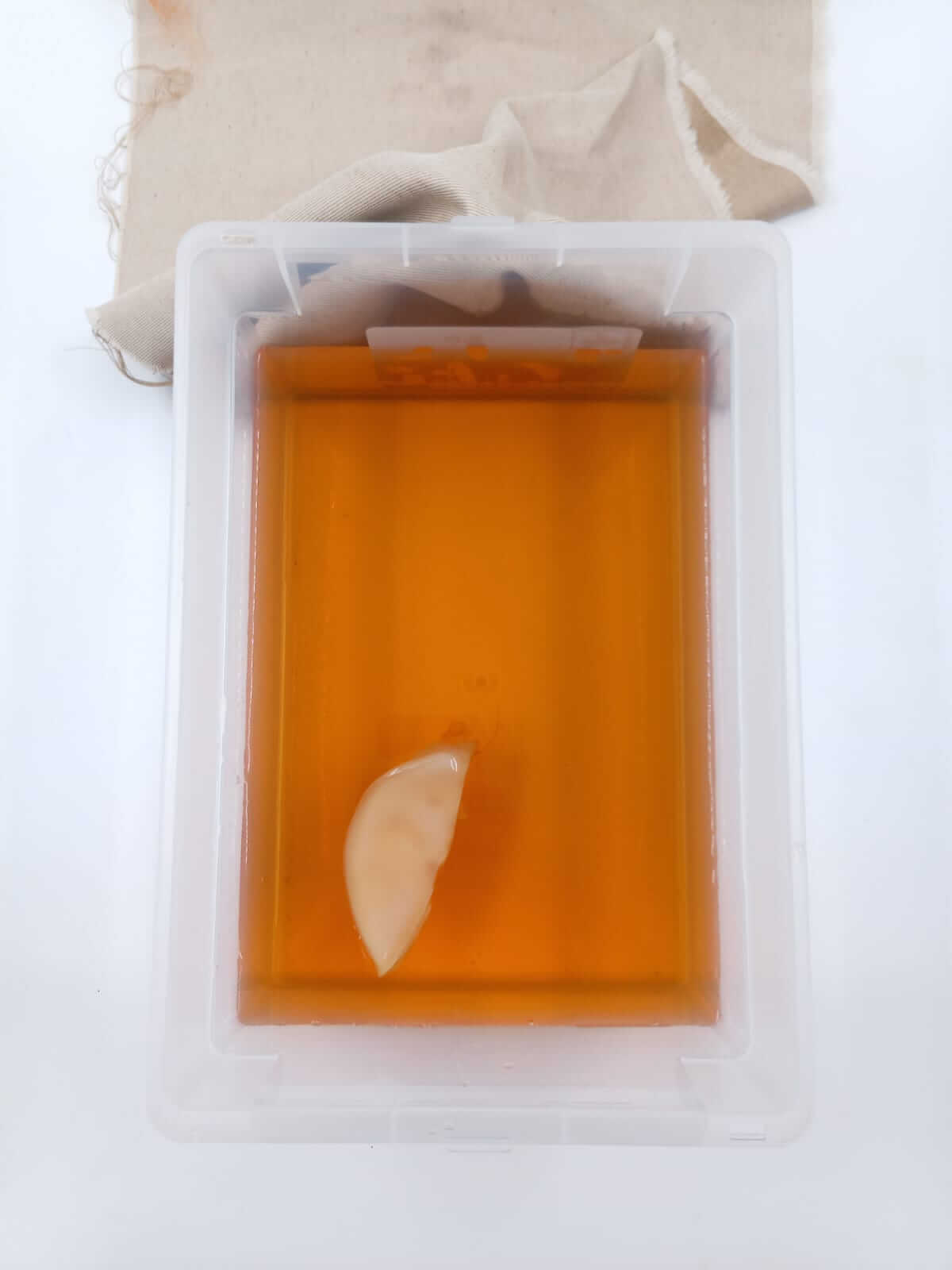
After 14 weeks, we harvested the kombucha leather. First, we gently took it out of the bucket and then cleaned it with soap until it was not sticky anymore. Kombucha is very fragile and the one we produced was still very thin despite the 14 weeks of growth, so we had to be extra careful.
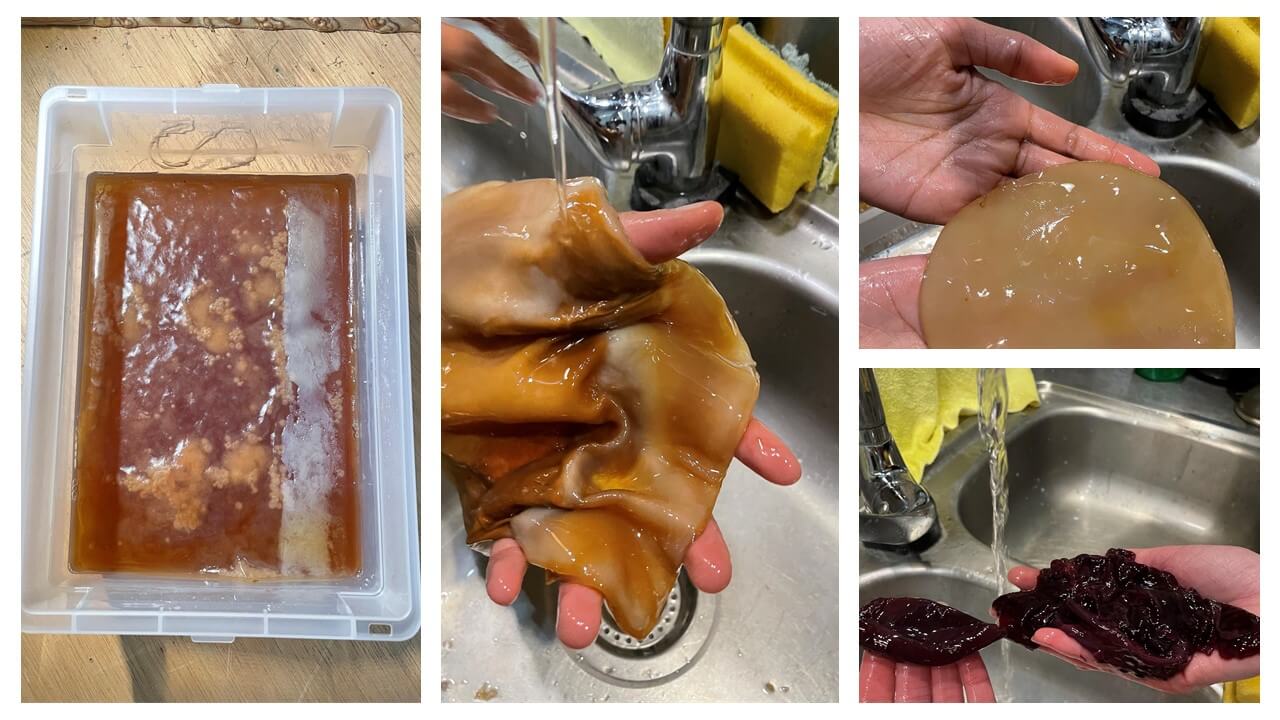
After the cleaning, the Kombucha was put to dry on a wooden board. When the kombucha film was too thin, it was folded into two and pressed very well so that it would only form one layer.

We left it to dry until it reached a pleasant texture and then coated it with a mixture of olive oil and bees wax (3:1 ratio). This is the final outcome of the kombucha leather samples :

During this week, I also heard about Barbara Artaega's final fabricademy project on electrospinning Kombucha cellulose to produce garments with a textile like (and not leather like) texture. This project is also inspiring for my final project.
IV-Bioplastics¶
As previously stated, plastic is a great material used the wrong way. It is used for disposable purposes not lasting more than a month while its lifespawn exceeds hundreds of years. It is however possible to make plastic out of natural ressources and not out of petrochemistry, that are biodegradable and have a much shorter lifespawn.
To make a plastic, one needs a polymer and a plasticizer. A lot of natural polymers exist such as glycerine, agar, alginate, starch, pine resin, chitines... The plasticizer is usually glycerine, and helps give it more flexibility and elasticity and make it less encline to shrinkage. The polymer or the plasticizer can have different proprieties. For instance, chitines have antibacterial proprieties. Then, color, fibers, fillers or foaming agents can be added to modify the proprieties of the plastic.
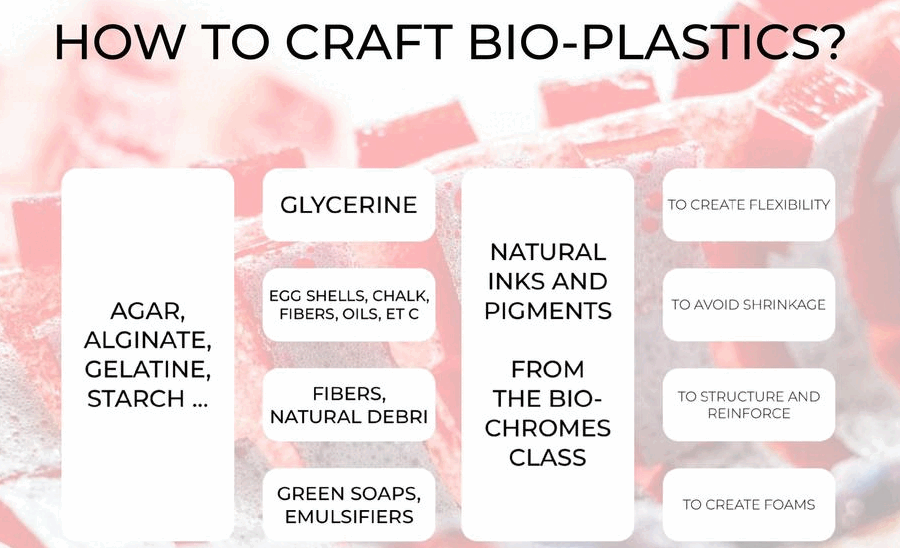
This week, each of us had to choose some parameters to test on the different types of bioplastics. I chose to put in each bioplastic some shredded fabric to make it more resistant, some activated charcoal to check the conductivity and some mika powder for funky colors!
 Remember this guy from week 3, the waste of the "0 waste" modular garments? That's the one I used !
Remember this guy from week 3, the waste of the "0 waste" modular garments? That's the one I used !
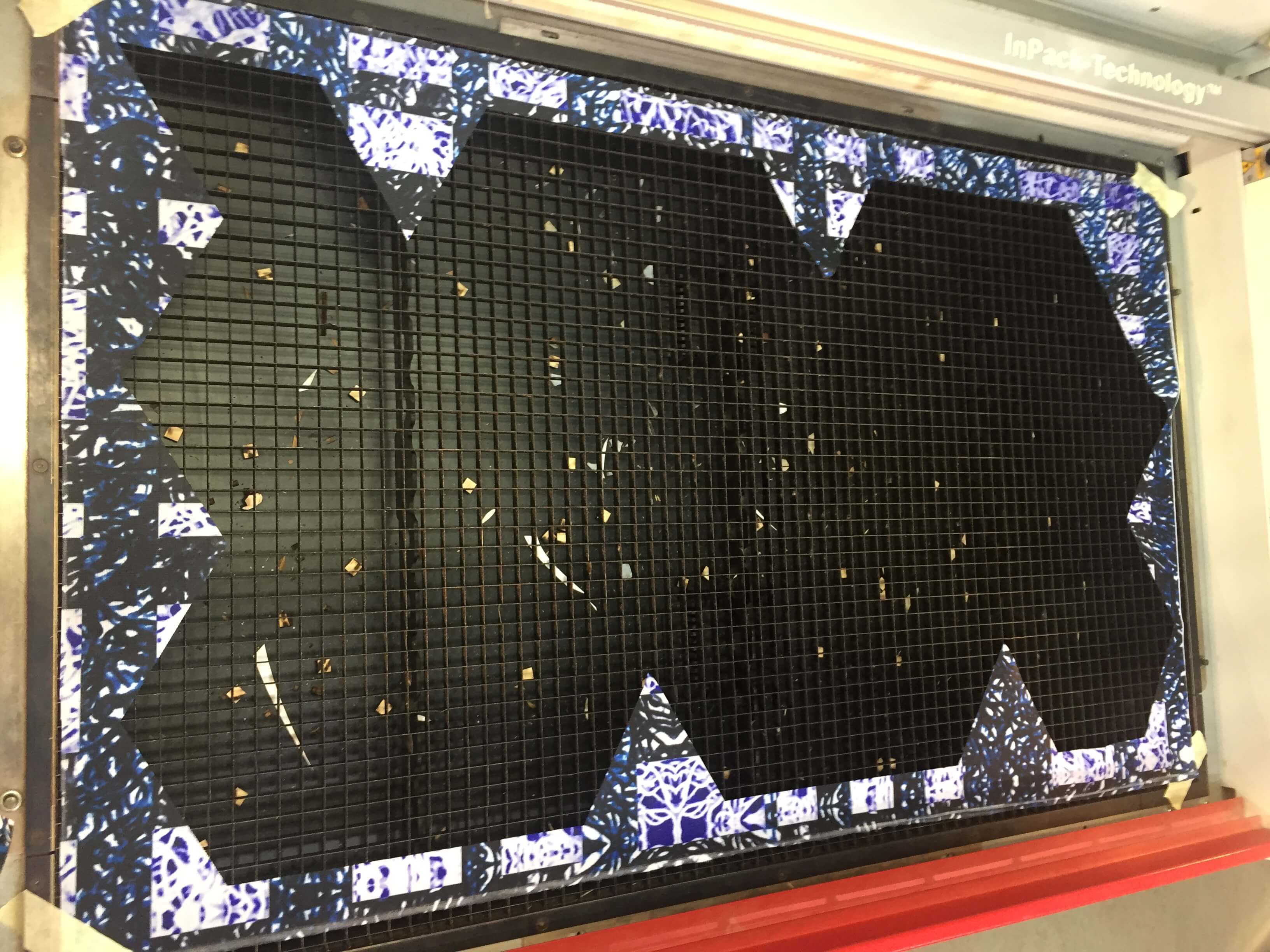
a-Alginate bioplastic¶
Alginate is a polymer obtained from brown algae with specific proprieties. The plasic making process does not require heat and it becomes water resistant when sprayed with calcium chloride, forming a thin solid pelicula. It is used in the textile industry to make clothes water resistant. The Alginate bioplastic is also thermo-resistant to temperatures up to 150°C. The plastic obtained is flexible but not elastic.
For experimenting with this recipe, I used the basic recipe using 4gr alginate sodium, 8gr glycerine and 200ml water and mixed it all together with a mixer. I added 2 lab spoons of activated charcoal, and a pinch of mika and some shredded fabric. I then casted the mix making sure to spray it with a 10 %w/v calcium chloride solution on both sides. I also made sure to use a porous material to cast it so that the plastic would stick a bit more to it and keep it's shape, avoiding shrinking. Then, I let it dry in the dryer.
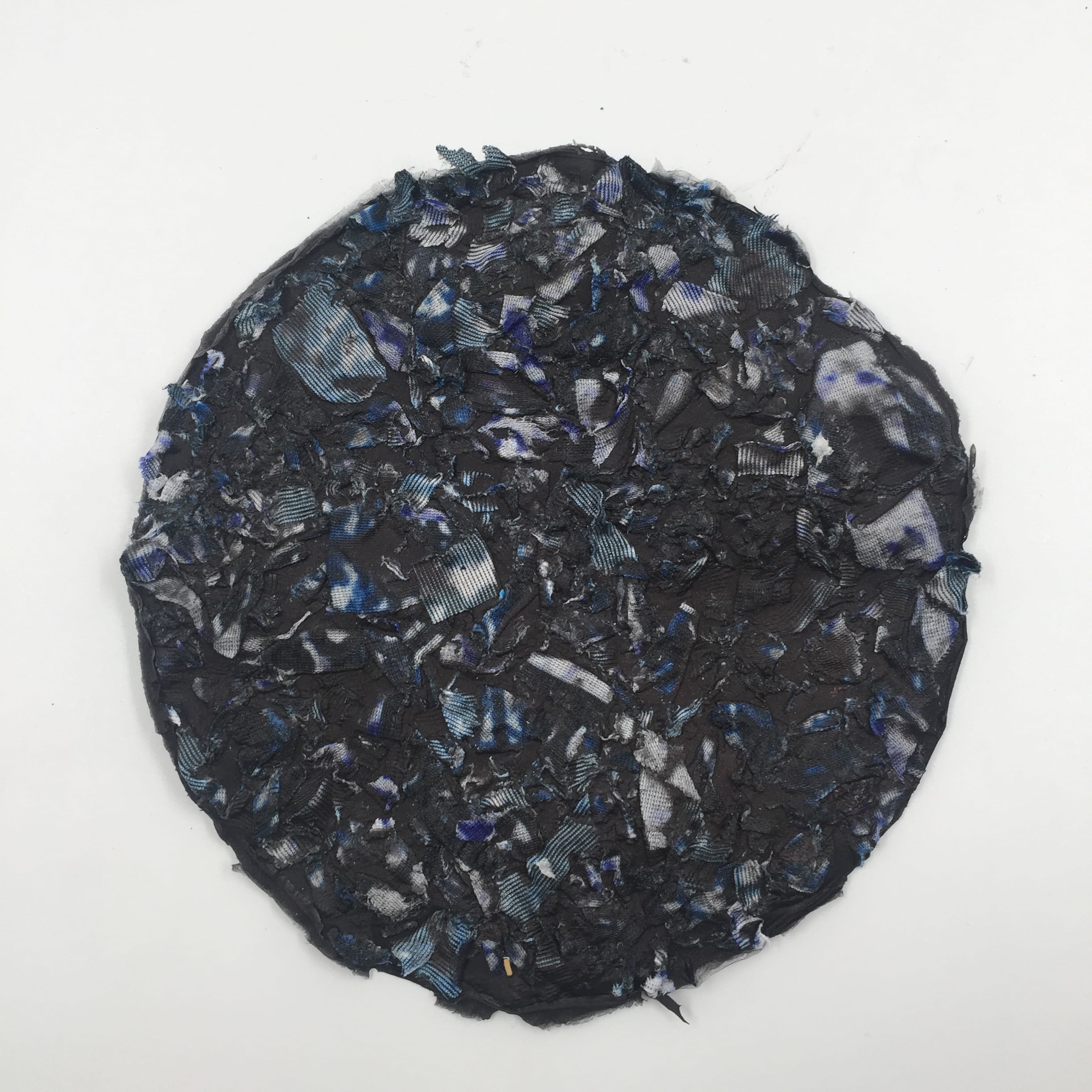
The final result led me to a very flexible yet very resistant bioplastic thanks to the fabric, and displayed a resistance of 1400K ohms from one diametral opposite to the other. Only negative point: I found the texture kind of unpleasant, but it is a feeling I share with all alginate bioplastics.
From all bioplastics, I think it has the best proprieties with the thermo resistance and the process not needing heat. I would like for further attempts to make a smoother alginate bioplastic that could also be more rigid to make biodegradable water bottles.
b-Gelatine bioplasics¶
Gelatine is an animal derived ingredient, often pig fat, seen as a waste in the food industry. It is possible to reach different textures depending on the amount of glycerin added to the mixture, resulting in textures ranging from resin-like to elastic plastic. The process of making gelatin plastic requires heat, but this material can always be remelted, recasted and is very versatile to work with. In the other hand, it is not very heat resistant and melts at temperatures over 35°C.
To make my gelatin fabric, I used the basic recipe for a normal bioplastic using 240 ml water, 24g glycerin and 48 gr of gelatin. As previously, I added 2 lab spoons of activated charcoal, and a pinch of mika. I heat it up but did not reach the boiling point (very important if you do not want to have a resin) and casted it in an embroidery circle with some shredded fabric (same amount and same fabric). I made sure to cast the gelatin bioplastic on a non porous surface (plastic tablecloth) to be able to detach it afterwards.

 Once dried, the bioplastic was very thick and dense, very resistant. The flexibility was comparable as the one of an inflatable matress and the textile fibers were well trapped inside the plasic, making it stronger. The activated charcoal did not confer conductive proprieties to the material even though I added the same amount as in the alginate bioplastic.
Once dried, the bioplastic was very thick and dense, very resistant. The flexibility was comparable as the one of an inflatable matress and the textile fibers were well trapped inside the plasic, making it stronger. The activated charcoal did not confer conductive proprieties to the material even though I added the same amount as in the alginate bioplastic.
3D bioplastic using a mold¶
Even if I kind of gave up on it since I moved to Barcelona, I am aiming to live a 0 plastic waste lifestyle. When I saw in the Fabricademy Barcelona bioplastics library that it was possible to make such different types of plastic, I was really excited. Since I arrived, I have been buying this same box of hummus with 3 different tastes in 3 distinct compartments. I usually eat it in 4 meals so between the time I buy it and the time I throw the plastic box away, there is usually not more than a week. Since I like that hummus so much and it has this interesting 3 compartements shape, I decided to 1) recreate the case in bioplastic and 2) stop buying it and make it myself. Since the case is supposed to hold food, I decided to make it in gelatin for the texture and to put natural pigment from onion skins obtained in the natural dyes week. I used 480 mL water, 96gr gelatin, 30gr glycerin and a teaspoon of onion pigments. I boiled the mixture and poured it in a bowl with my hummus mold on top and let it dry.
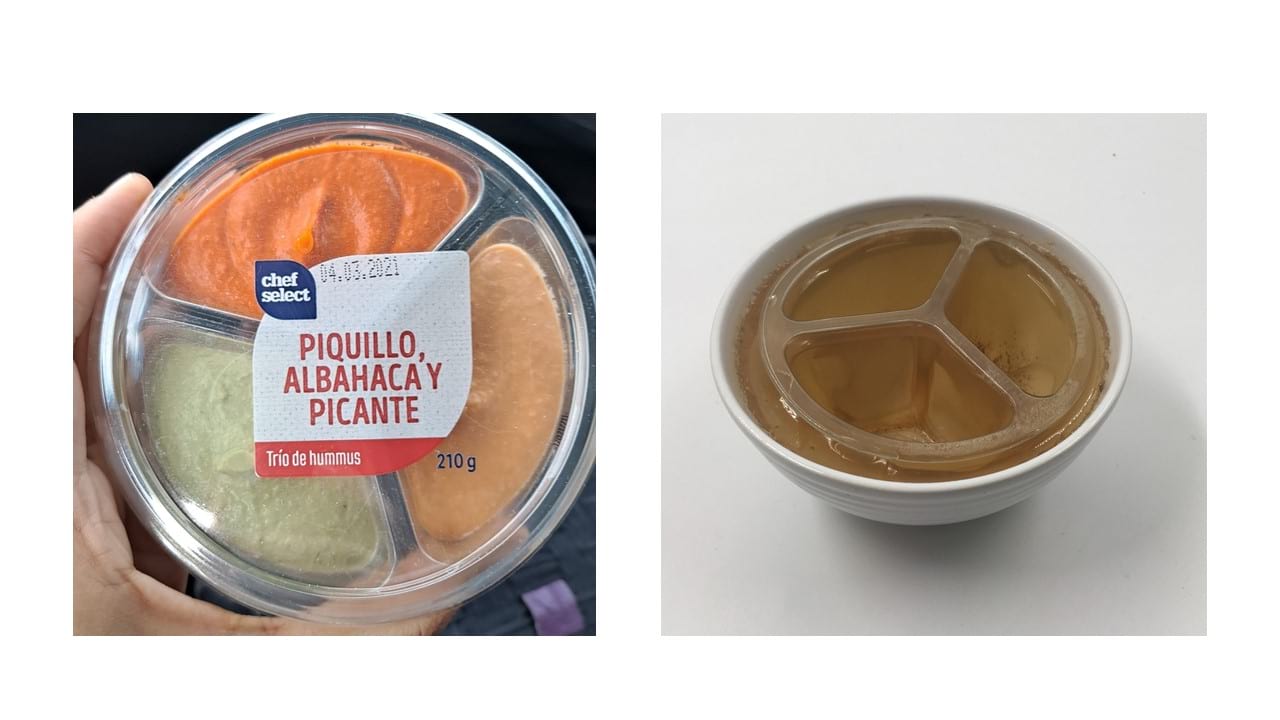



These images show the mold and a comparison with the final object. I have to say the final object does not really look as I wanted it to look like because it shrank A LOT. Since the object was really moist, I had to take the object out of the mold to allow it to dry and minimize the moulds, but then nothing was keeping the structure in shape. The other inconvenient was that it was CONSTANTLY molding so I had to clean it with ethanol regularly but could not avoid some deterioration. But for a first attempt of a 3D object, it is not too bad. If it had to be done a second time, I would use a meshy structure with holes letting the air touch the object in order to let it dry but keeping the shape of it. The final object is very rigid and feels like thick plastic and could totally hold food, which is exactly the desired result.
c-Agar bioplastic¶
Agar comes from red algae. It is a diholoside and the process of making bioplastic out of it is a bit more complicated than the other ones since it needs to be heated slowly and casted at a very special moment. To make it, I mixed 300ml water, 10g agar, 16g glycerol and a pinch mika powder. Unfortunately, there was no more activated charcoal so I could not keep all conditions the same for all my biomaterials. I stired it well in a pot and heated it by increasing the temperature every two minuts. When the smell changed, I knew it was ready to be poured. I poured it in an embroidery circle where I put my shredded fabric with a porous material on the bottom to avoid the shrinkage.
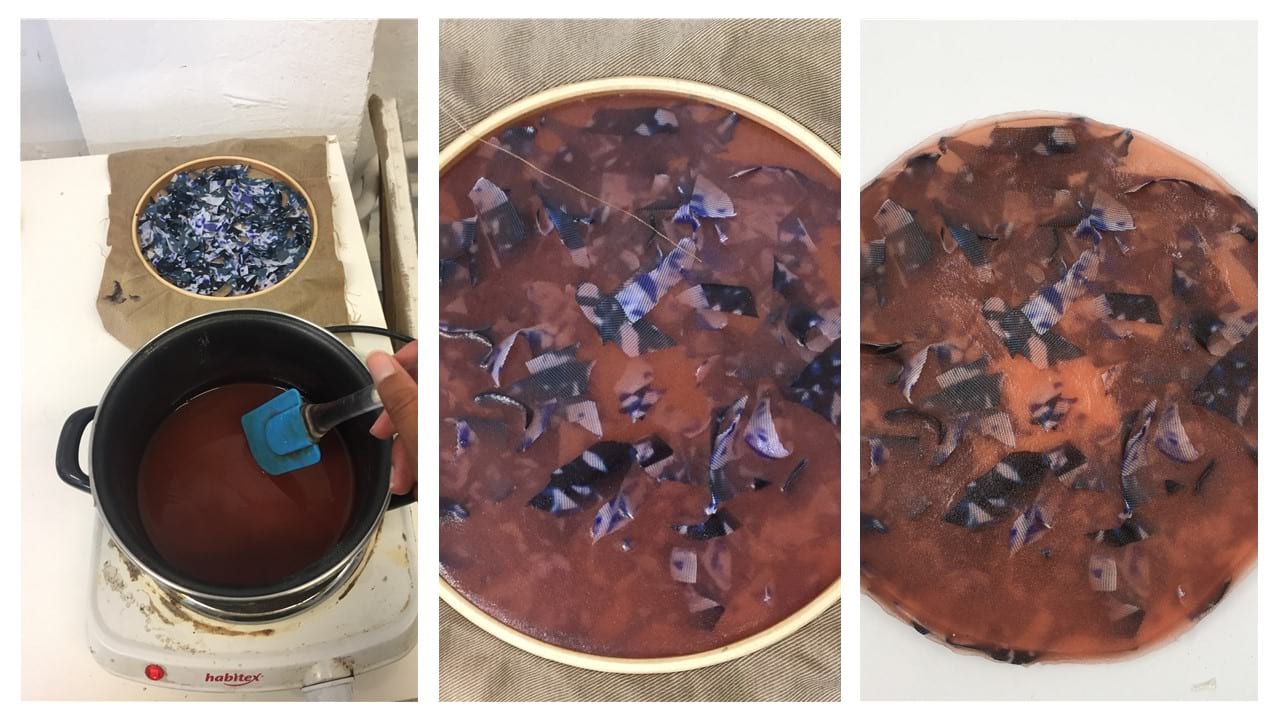
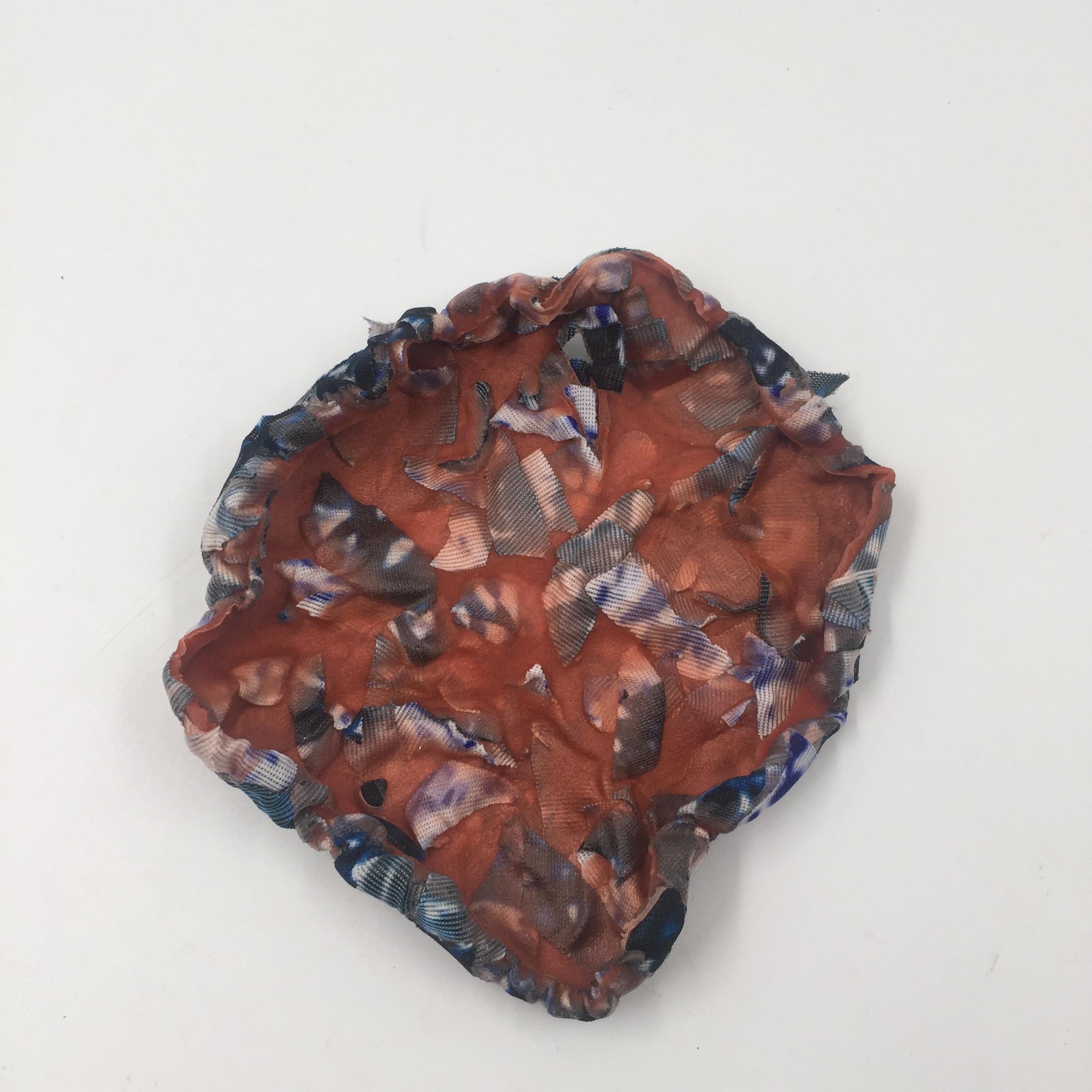 I dried this bioplastic in the dryer and... it shrank. The result is pretty interesting because :
I dried this bioplastic in the dryer and... it shrank. The result is pretty interesting because :
- it seems like agar bioplastic does not really like material of such a big size. The plastic seemed weakened by the material because it solidified around it and not really with the material, as if it rejected it.
- The texture of the mix of bioplastic and half-incorporated fabric gave an interesting feeling, a little bit spongy/foamy.
- Make sure to put some weight on the bioplastic when drying it so that it does not shrink!
V-Other recipes: pine resine and starch¶
It is also possible to make some plastic-like material out of pine resin and out of starch. - pine resin: in a pot, pour 45g pine resin and 20 ml alcohol. Heat up without mixing until the pine resin is melted. Add a filler (avocado pits, coffee grounds...) and 5gr carnauba wax. Once melted, quickly pour in the mold and wait for 10min to cool down and solidify. - starch: in a pot, mix 300 ml water, 8gr potato starch, 60 mL vinegar and, depending on the desired texture, no glycerine (rigid), 40 (normal) or 80g (elastic) glycerine . Stir well and heat until reaching a thicker paste. Spread on a mold and let dry, then bake in an oven.
d-Summary of recipes¶
| PLASTIC TYPE | ALGINATE | GELATINE | AGAR | STARCH | PINE RESIN |
|---|---|---|---|---|---|
| POLYMER | 4g | 48g | 10g | 60g | 45g |
| SOLVANT | 200mL water | 240mL water | 300mL water | 300mL water & 60mL vinegar | 20mL ethanol |
| PLASTICIZER | 8g glycerine | R:0g glycerine; N:24g; E: 48g | R:4g glycerine; N:16g; E: 32g | R:Og glycerine; N:40g; E: 80g | 5gr carnauba wax |
| HEAT | No heat, solidify with calcium chloride | Heat (no boiling) | Slow heat until smell changes | Heat then bake | Heat and add 40g filler |
R: rigid; N: normal; E: elastic.

VI-Materfad visit and additional project idea¶
This week, we had the amazing opportunity to visit Materfad, the material collection of the design museum of Barcelona. We met Robert Thompson Casas who showed us a large range of amazing materials as a human dictionnary. Here is a selection of information I learnt from the most amazing fibers I saw.

-
Basalte fibers can be obtained by electrospinning. For it, the rock has to be melted first. I comes in brown color and can be mixed with other minerals to change that. It is reflective, iridescent and extremely non elastic (unsurprisingly). This material is very specific and complicated to obtain but can be used for its rigidity for reinforcing materials. It is particularly non conductive thermically and absorbs some light frequences. As it is a very specific material, it is used in very specific applications that require these kind of proprieties. The price ranges between glass and carbon fibers.
-
Hemp. Cooling effect, water resistant, requires little water and little pesticide to grow. Very high percentage of cellulose (75%). It can produce a large range of products, from canvas to cashmere .
-
RMT fibers is a company that makes bricks of non woven fabric. They are a mix of wool and plant fibers, used for cushoning (in cars to replace polyurethane foams) or isolation. Wool has many proprieties such as the absorbtion of smells, pollutants and humidity. It can be covered in borax to repell bugs and molds or in waterglass for water and fire resistance.
-
Metal fabric can be obtained by using thin metal fibers and weaving them. Steel is presented in the following picture and could for instance be used for its specific proprieties like making reinforcments in pockets, isolating the wearer from phone or electrival devices waves and making a Faradet cage. Will it isolate the waves though?
-
Semi rigid textiles incorporating wood (biocomposites) look absolutelty amazing. Tannins and urea can be used to wash wood and make it more flexible (eliminates lignin).
-
Natural coatings : urea, casein from milk (make yarn from milk, but also buttons in a material called galelith), chitin from arthropods shells (contains acerylglucosamine, transparent, antibacterial proprieties, hydrophobic, polymerisable when sonicated and mixed with epichlorohydrine, aldehydes or acids).
-
Human hair (human) is an amazing material composed of 12 proteins, elastic when wet, hollow. It has a high content of Keratine, making it possible to fuse with cystein bonds when pressed and heated. It can be degraded by microorganisms like Stenotrophomonas maltophilia, Bacillus subtilis, and Aeromonas spp. Keratin can also be extracted from animal fibers using urea and 1-allyl-3-methylimidazolium (used to depolymerize cellulose). Cellulose can be treated with an alkaline solution to give it the possibility to add more components inside, make it porous.
Biofilms are not that resistant, but can possibly be used as coat or color absorbant ? Or rolled and used as threads.

During her presentation, Jessca Dias told us that Mycelium could grow in very different conditions and adapt to diverse conditions also. She said some mycelium could be trained to grow on used cigarettes buts and on plastic. I was wondering if Mycelium could also grow on old unusable clothes or pieces of fabric and digest them into forming new threads.
As we visited the Materfad collection, I asked Robert about how to make Mycelium grow in fibers. He told me he was currently working on it and advised me to try to spread spores of Ganoderma lucidum or Pleurotus ostreatus on potato starch for my first experiments, and supplement the medium with 0,5 to 1% peroxydes to avoid molds. To know more about this experiment, see the page of Week 9: Textile as scaffold.